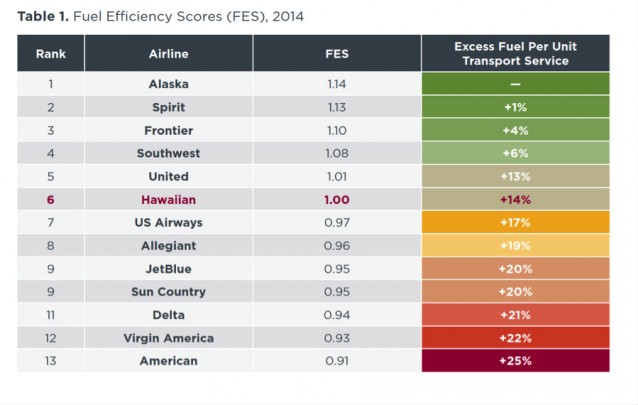
A study recently released by the International Council on Clean Transportation (ICCT) found a wide range in fuel efficiency for U.S. airlines. Among the 13 biggest airlines, the least efficient, American, used 25 percent more fuel per passenger mile than Alaskan Airlines, the most efficient way to fly.
Alaska, Spirit, Frontier, and Southwest Airlines — all so-called budget airlines — were the most fuel-efficient airlines for domestic flights in 2014. Other than American, Delta and Virgin America rounded out the worst performers. United and US Airways, the two other big airlines, were in the middle.

CREDIT: International Council on Clean Transportation
The 2014 airline ranking might be helpful for travelers interested in reducing their carbon footprint — or in getting the best deal. Fuel efficiency was tied to profitability, and in today’s world of competitive flight pricing, profitability means airlines can lower the cost passed on to consumers. Airlines, too, are interested in decreasing the amount of jet fuel they use on trip. Fuel is a significant portion of airlines’ costs, and decreases in emissions were tied in part to newer fleets, as the industry tries to push fuel costs down.
Ultimately, cost may be why budget airlines top the ICCT list.
Unfortunately, that efficiency come at a different cost — one to your kneecaps. The biggest driver in fuel reductions from 2013 to 2014 was tied to a 1.6 percent increase in “seating density,” according to the report. That means airlines are packing people more closely together. Maybe Airbus is on to something — the company filed a patent this past summer for a design to stack airline seats.
Other ways to improve efficiency and reduce emissions include mechanical improvements, using biofuels or other alternative fuels, or implementing a carbon fee, but some have argued that ticket prices would be an effective way of driving demand down. Research published last year in Atmospheric Environment suggested that the only way airline carbon emissions could be reduced overall, given the expected increase in demand for flights, would be to raise ticket prices.
However it is done, figuring out how to reduce emissions from airplanes is critical. Emissions from airplanes are a significant contributor of greenhouse gases, accounting for more than 10 percent of emissions from the transportation sector in the United States. Worldwide, if commercial aviation were a country, it would rank seventh after Germany in terms of carbon emissions, according to the ICCT.
The EPA has found that emissions from aircraft are a hazard to human health. That finding is the first step towards developing regulations.
Environmental groups had sued the EPA in order to move the process forward. Usually, when the EPA releases findings like those, it would also put out draft regulations. In this case, though, the EPA has deferred to the International Civil Aviation Organization (ICAO), a group organized by the United Nations. Environmental groups were not happy with the EPA’s decision, especially since the ICAO regulations will likely apply only to new aircraft.
If the process to curb airline emissions does not go forward, emissions are expected to more than triple by 2050, the ICCT said.